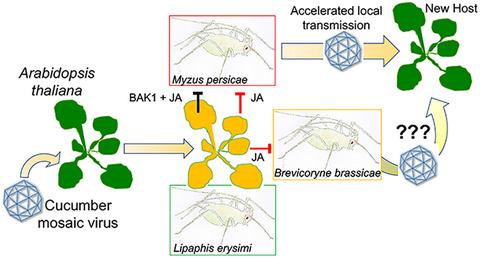当前位置:
X-MOL 学术
›
Mol. Plant Pathol.
›
论文详情
Our official English website, www.x-mol.net, welcomes your
feedback! (Note: you will need to create a separate account there.)
Infection of Arabidopsis by cucumber mosaic virus triggers jasmonate-dependent resistance to aphids that relies partly on the pattern-triggered immunity factor BAK1
Molecular Plant Pathology ( IF 4.8 ) Pub Date : 2021-06-22 , DOI: 10.1111/mpp.13098 Trisna Tungadi 1, 2 , Lewis G Watt 1 , Simon C Groen 1 , Alex M Murphy 1 , Zhiyou Du 1, 3 , Adrienne E Pate 1 , Jack H Westwood 1 , Thea G Fennell 1 , Glen Powell 2 , John P Carr 1
Molecular Plant Pathology ( IF 4.8 ) Pub Date : 2021-06-22 , DOI: 10.1111/mpp.13098 Trisna Tungadi 1, 2 , Lewis G Watt 1 , Simon C Groen 1 , Alex M Murphy 1 , Zhiyou Du 1, 3 , Adrienne E Pate 1 , Jack H Westwood 1 , Thea G Fennell 1 , Glen Powell 2 , John P Carr 1
Affiliation

|
Many aphid-vectored viruses are transmitted nonpersistently via transient attachment of virus particles to aphid mouthparts and are most effectively acquired or transmitted during brief stylet punctures of epidermal cells. In Arabidopsis thaliana, the aphid-transmitted virus cucumber mosaic virus (CMV) induces feeding deterrence against the polyphagous aphid Myzus persicae. This form of resistance inhibits prolonged phloem feeding but promotes virus acquisition by aphids because it encourages probing of plant epidermal cells. When aphids are confined on CMV-infected plants, feeding deterrence reduces their growth and reproduction. We found that CMV-induced inhibition of growth as well as CMV-induced inhibition of reproduction of M. persicae are dependent upon jasmonate-mediated signalling. BRASSINOSTEROID INSENSITIVE1-ASSOCIATED KINASE1 (BAK1) is a co-receptor enabling detection of microbe-associated molecular patterns and induction of pattern-triggered immunity (PTI). In plants carrying the mutant bak1-5 allele, CMV induced inhibition of M. persicae reproduction but not inhibition of aphid growth. We conclude that in wildtype plants CMV induces two mechanisms that diminish performance of M. persicae: a jasmonate-dependent and PTI-dependent mechanism that inhibits aphid growth, and a jasmonate-dependent, PTI-independent mechanism that inhibits reproduction. The growth of two crucifer specialist aphids, Lipaphis erysimi and Brevicoryne brassicae, was not affected when confined on CMV-infected A. thaliana. However, B. brassicae reproduction was inhibited on CMV-infected plants. This suggests that in A. thaliana CMV-induced resistance to aphids, which is thought to incentivize virus vectoring, has greater effects on polyphagous than on crucifer specialist aphids.
中文翻译:

黄瓜花叶病毒感染拟南芥引发茉莉酸依赖性对蚜虫的抗性,这部分依赖于模式触发的免疫因子 BAK1
许多以蚜虫为载体的病毒通过病毒颗粒短暂附着在蚜虫口器上非持久性传播,并且在表皮细胞的短探针刺穿期间最有效地获得或传播。在拟南芥中,蚜虫传播的病毒黄瓜花叶病毒 (CMV) 可诱导对多食性蚜虫桃蚜的摄食威慑。这种形式的抗性抑制了长时间的韧皮部摄食,但促进了蚜虫对病毒的获取,因为它促进了植物表皮细胞的探测。当蚜虫被限制在感染 CMV 的植物上时,摄食威慑会降低它们的生长和繁殖。我们发现 CMV 诱导的生长抑制以及 CMV 诱导的M繁殖抑制。 桃依赖于茉莉酸介导的信号传导。芸苔素不敏感 1 相关激酶 1 (BAK1) 是一种能够检测微生物相关分子模式和诱导模式触发免疫 (PTI) 的共同受体。在携带突变bak1-5等位基因的植物中,CMV 诱导了M的抑制。 persicae繁殖但不抑制蚜虫生长。我们得出结论,在野生型植物中,CMV 诱导了两种降低M性能的机制。 persicae:抑制蚜虫生长的茉莉酸依赖和PTI依赖的机制,以及抑制繁殖的茉莉酸依赖的、不依赖PTI的机制。两种十字花科植物蚜虫Lipaphis erysimi的生长和Brevicoryne brasicae ,当限制在CMV感染的拟南芥上时不受影响。然而,B。 受CMV感染的植物抑制了芸苔属的繁殖。这表明,在拟南芥中, CMV 诱导的对蚜虫的抗性(被认为可以刺激病毒载体)对多食性动物的影响大于对十字花科专长蚜虫的影响。
更新日期:2021-08-12
中文翻译:

黄瓜花叶病毒感染拟南芥引发茉莉酸依赖性对蚜虫的抗性,这部分依赖于模式触发的免疫因子 BAK1
许多以蚜虫为载体的病毒通过病毒颗粒短暂附着在蚜虫口器上非持久性传播,并且在表皮细胞的短探针刺穿期间最有效地获得或传播。在拟南芥中,蚜虫传播的病毒黄瓜花叶病毒 (CMV) 可诱导对多食性蚜虫桃蚜的摄食威慑。这种形式的抗性抑制了长时间的韧皮部摄食,但促进了蚜虫对病毒的获取,因为它促进了植物表皮细胞的探测。当蚜虫被限制在感染 CMV 的植物上时,摄食威慑会降低它们的生长和繁殖。我们发现 CMV 诱导的生长抑制以及 CMV 诱导的M繁殖抑制。 桃依赖于茉莉酸介导的信号传导。芸苔素不敏感 1 相关激酶 1 (BAK1) 是一种能够检测微生物相关分子模式和诱导模式触发免疫 (PTI) 的共同受体。在携带突变bak1-5等位基因的植物中,CMV 诱导了M的抑制。 persicae繁殖但不抑制蚜虫生长。我们得出结论,在野生型植物中,CMV 诱导了两种降低M性能的机制。 persicae:抑制蚜虫生长的茉莉酸依赖和PTI依赖的机制,以及抑制繁殖的茉莉酸依赖的、不依赖PTI的机制。两种十字花科植物蚜虫Lipaphis erysimi的生长和Brevicoryne brasicae ,当限制在CMV感染的拟南芥上时不受影响。然而,B。 受CMV感染的植物抑制了芸苔属的繁殖。这表明,在拟南芥中, CMV 诱导的对蚜虫的抗性(被认为可以刺激病毒载体)对多食性动物的影响大于对十字花科专长蚜虫的影响。











































 京公网安备 11010802027423号
京公网安备 11010802027423号